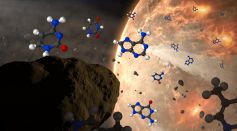Tags: Origin of life
3.5-Billion-Year-Old Rock Reveals Complex Microbial Communities; Rich Ecosystem Could Be Key to the First Life on Earth

Decoding Molecular Languages at the Origin of Life Opens New Opportunities in Developing Nanotechnologies

Purdue University Chemists Unveil Paths of 'Chemistry After the Origin of Life' [A Study]

Chemical Reaction Using Cyanide, Ammonia and Carbon Dioxide Yields Amino Acids Maybe the Origin of Life

Experts Complete DNA and RNA Nucleobases from Meteorites, Supports Origin of Life from Space

Quantum Mechanical Tunneling May Explain How Life Appeared on Earth

Origin of Life Revealed! Protein Structures May Answer How Life Began on Earth

Origin of Life Allegedly Driven By Organisms From Outer Space

Chinese Scientists Discover Material in Rock That May Exhibit ‘Origin of Life’

Hydrothermal Vents May Be The Exact Location of the Origin of Life
New Study Shows that Life on Earth Began in a Shallow Pond, Not in the Ocean
Journey Of Life: Study Suggests Life Originated In Space Not Earth
The Origin Of Life: Biochemist Presumes The Influence Of Enzyme-Free Krebs Cycle Behind It
Study Reveals New Insights On Origin Of Life
Most Popular

Will Earth's Magnetic Poles Flip Next? Magnetic Pole Reversal Explained Through Cutting‑Edge Magnetosphere Science

Relativity Time Dilation Explained: The Physics of Time and Why It Moves Differently in Space

How Lightning Science Reveals Why Charged Storms Are Rising with Global Warming Effects

How AI Is Used in Weather Prediction: Smarter Forecasting Through Machine Learning




